Physical Address
304 North Cardinal St.
Dorchester Center, MA 02124
Physical Address
304 North Cardinal St.
Dorchester Center, MA 02124
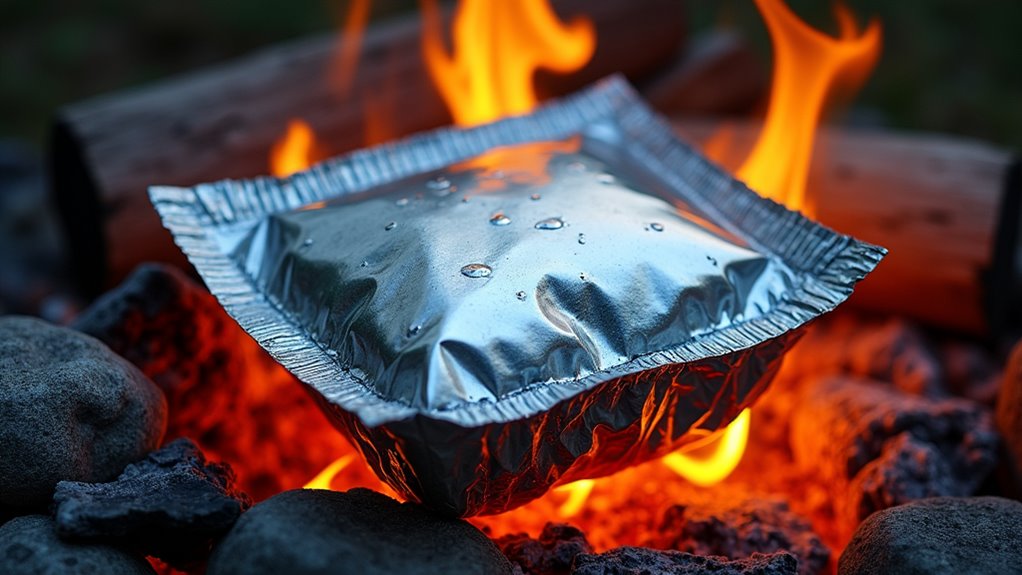
Perfect foil packet cooking requires mastering coal beds, not flames—discover the secret technique that transforms basic campfire meals into gourmet experiences.
You might not realize that the key to perfect foil packet cooking isn’t the fire itself, but the coal bed you create beneath it. Most campers make the mistake of cooking directly over flames, which leads to burnt outsides and raw centers. Instead, you’ll want to master the art of building and maintaining that sweet spot of glowing embers. There’s a specific technique for creating these packets that’ll transform your campfire meals from mediocre to restaurant-quality.
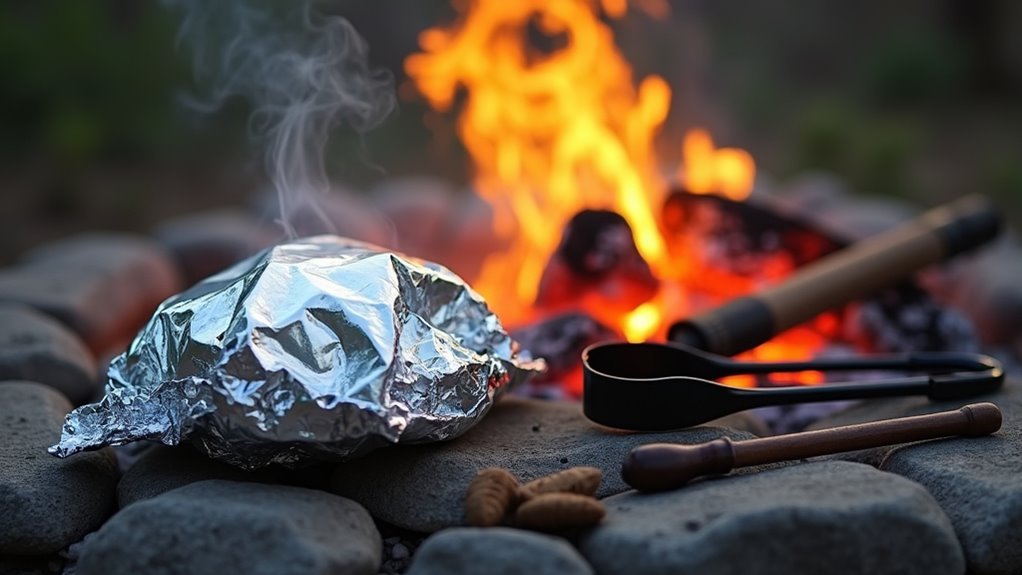
When you’re planning a campfire cooking adventure, your success hinges on selecting the right foil and gathering essential equipment before you head outdoors. Choose heavy-duty aluminum foil over regular thickness – it won’t tear when you’re wrapping food or moving packets around hot coals. Stock up on extra foil since you’ll use more than expected.
Essential tools include long-handled tongs for safely moving foil packets, heat-resistant gloves for protection, and a small shovel or poker to manage coals. Pack a spray bottle for controlling flames and a cooler with ice packs to keep ingredients fresh.
Don’t forget basics like salt, pepper, butter, and olive oil. These simple seasonings transform basic ingredients into delicious campfire meals that’ll satisfy hungry campers. Make sure to include these items in your essential camping gear checklist alongside your cooking supplies for a well-rounded outdoor experience.
Once you’ve gathered your equipment and foil, the real magic happens when you build and manage your fire properly. Start your fire 45-60 minutes before cooking to develop hot coals. You’ll want hardwood like oak or hickory that burns down to consistent, glowing embers.
Create a two-zone system by raking coals to one side for direct heat and leaving the other side cooler for indirect cooking. Test coal temperature by holding your hand five inches above – if you can hold it for 3-4 seconds, it’s medium heat; 1-2 seconds means high heat.
Keep fresh wood burning separately to replenish coals as needed. Never place foil packets directly on flames – you’ll get uneven cooking and burnt food.
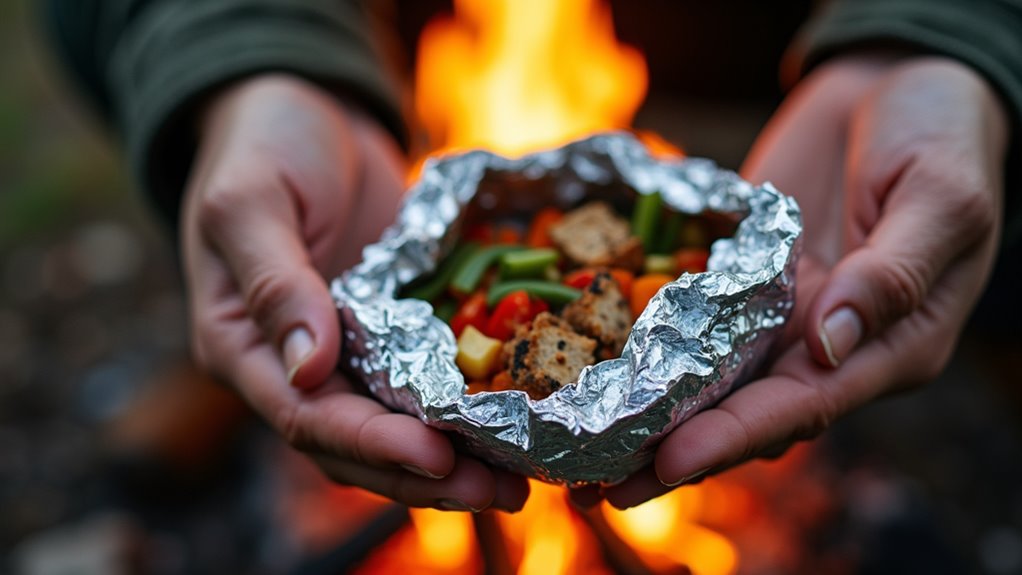
After you’ve prepared your coals, mastering the art of folding foil packets becomes critical to your cooking success. Start with heavy-duty aluminum foil, cutting pieces large enough to wrap your ingredients with extra room for sealing.
Place food in the center, then bring opposite edges together above the food. Fold the seam down in half-inch increments, pressing firmly to create a tight seal.
Next, fold the side edges inward, rolling them toward the packet’s center. Don’t wrap too tightly—leave space for steam circulation.
Test your seal by gently pressing the packet. If air escapes, refold those areas. Double-wrap delicate items or foods with high moisture content.
Properly sealed packets prevent messy leaks and ensure even cooking over your campfire coals. Remember that creating a campfire requires proper preparation and technique to achieve the consistent heat needed for successful foil packet cooking.
Now that you’ve got your sealing technique down, you’ll want to put those skills to work with vegetables and sides that truly shine in foil packets. Root vegetables like potatoes, carrots, and onions work beautifully – they steam perfectly and won’t fall through grill grates. Cut them into uniform pieces, add butter, salt, and herbs like rosemary or thyme.
Root vegetables like potatoes, carrots, and onions steam beautifully in foil packets and won’t slip through your grill grates.
Try corn on the cob with garlic butter, or mix bell peppers with zucchini and Italian seasoning. For heartier sides, combine diced potatoes with bacon bits and cheese.
Asparagus spears need just olive oil, lemon, and pepper – they’ll cook in 10-15 minutes.
Remember to add moisture through butter, oil, or even wine. Your vegetables will steam in their own juices, creating tender, flavorful results.
When camping with young children, keep safety tips in mind by ensuring hot foil packets are handled by adults and placed safely away from little hands.
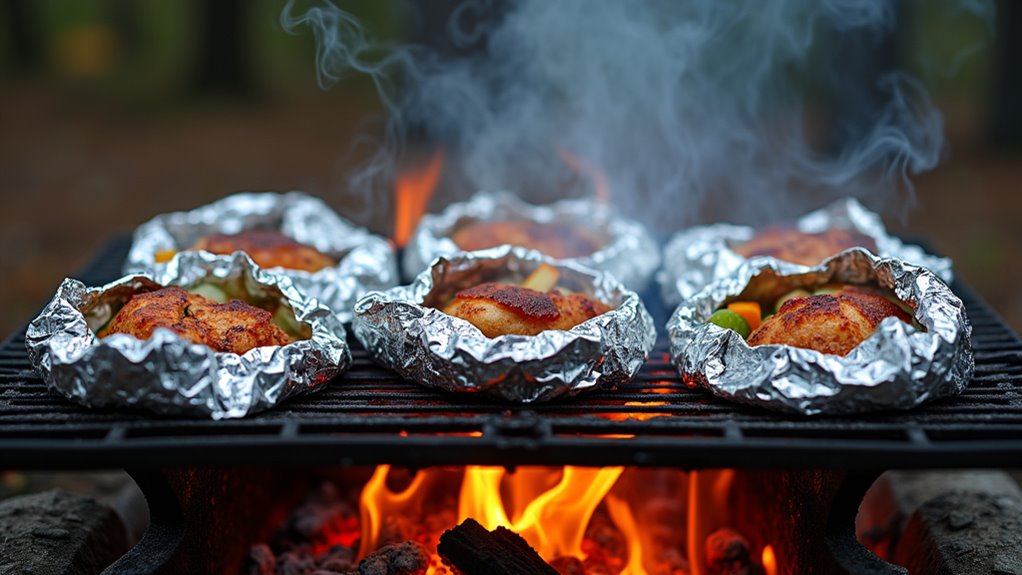
While vegetables make excellent foil packet sides, protein transforms these simple meals into satisfying campfire feasts. You’ll find chicken thighs work better than breasts since they won’t dry out over the coals. Season them with garlic, herbs, and lemon before wrapping with potatoes and onions.
Fish cooks quickly in foil – try salmon with dill and butter, or white fish with Mediterranean vegetables. Don’t overcook; fish flakes easily when done.
Ground beef makes hearty packets when formed into patties with bell peppers and mushrooms. Add cheese in the final minutes for melted goodness.
Sausages pair perfectly with peppers and onions, creating classic Italian-inspired packets. Pre-cook dense vegetables like carrots to ensure everything finishes simultaneously.
Whether you’re working with a portable camping stove or an open fire, mastering these camp cooking techniques will elevate your outdoor dining experience from basic sustenance to memorable meals.
Getting your foil packets perfectly cooked requires mastering the balance between heat and time, since you can’t easily check doneness without unwrapping everything.
You’ll want medium-hot coals, not blazing flames that’ll char your food’s exterior while leaving the inside raw. Test coal temperature by holding your hand five inches above – you should only manage 3-4 seconds before pulling away.
Cook chicken and pork packets 20-25 minutes, flipping once halfway through. Fish needs just 12-15 minutes, while beef requires 15-20 minutes depending on thickness. Vegetables alone cook in 10-15 minutes.
Place packets on coal edges rather than directly over the hottest spots. If you hear aggressive sizzling, move them further out.
Patience beats rushing – undercooked food ruins camping trips. Mastering campfire cooking skills will help you make the most of your travel budget when exploring outdoor destinations across the UK.
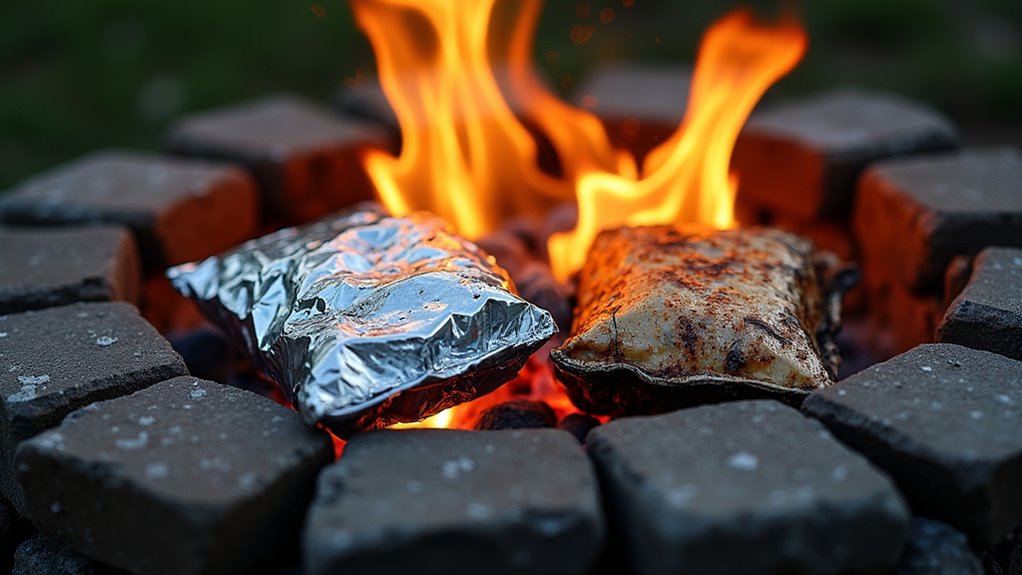
Even with perfect timing and temperature control, foil packet cooking can go sideways fast when you skip basic safety steps. Never use regular aluminum foil near open flames – it’ll tear and spill your dinner into the coals. Heavy-duty foil‘s your only option here.
Don’t grab packets with bare hands. Those suckers stay blazing hot long after you pull them from the fire. Use tongs or thick gloves every time.
Skip the tight seal temptation. Overpacked packets explode from steam buildup, creating a mess and potential burns. Leave breathing room and crimp edges loosely.
Test doneness by poking through the foil with a fork, not by unwrapping everything. You’ll lose heat and cook unevenly. Trust your timing, then verify with minimal exposure.
Always keep water nearby when cooking over an open flame, as proper campfire safety requires having extinguishing materials readily available in case of flare-ups or accidents.
You’ve discovered the secret to effortless campfire dining – foil packet cooking is your golden ticket to memorable outdoor meals. With practice, you’ll master the art of creating these flavor-packed bundles that practically cook themselves while you’re swapping stories around the fire. Don’t let cleanup steal your camping thunder; embrace this foolproof method and watch your fellow campers beg for your culinary secrets. Your next wilderness adventure just got infinitely more delicious.